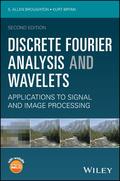Discrete Fourier Analysis and Wavelets
Applications to Signal and Image Processing

2. Edition May 2018
464 Pages, Hardcover
Wiley & Sons Ltd
Delivers an appropriate mix of theory and applications to help readers understand the process and problems of image and signal analysis
Maintaining a comprehensive and accessible treatment of the concepts, methods, and applications of signal and image data transformation, this Second Edition of Discrete Fourier Analysis and Wavelets: Applications to Signal and Image Processing features updated and revised coverage throughout with an emphasis on key and recent developments in the field of signal and image processing. Topical coverage includes: vector spaces, signals, and images; the discrete Fourier transform; the discrete cosine transform; convolution and filtering; windowing and localization; spectrograms; frames; filter banks; lifting schemes; and wavelets.
Discrete Fourier Analysis and Wavelets introduces a new chapter on frames--a new technology in which signals, images, and other data are redundantly measured. This redundancy allows for more sophisticated signal analysis. The new coverage also expands upon the discussion on spectrograms using a frames approach. In addition, the book includes a new chapter on lifting schemes for wavelets and provides a variation on the original low-pass/high-pass filter bank approach to the design and implementation of wavelets. These new chapters also include appropriate exercises and MATLAB® projects for further experimentation and practice.
* Features updated and revised content throughout, continues to emphasize discrete and digital methods, and utilizes MATLAB® to illustrate these concepts
* Contains two new chapters on frames and lifting schemes, which take into account crucial new advances in the field of signal and image processing
* Expands the discussion on spectrograms using a frames approach, which is an ideal method for reconstructing signals after information has been lost or corrupted (packet erasure)
* Maintains a comprehensive treatment of linear signal processing for audio and image signals with a well-balanced and accessible selection of topics that appeal to a diverse audience within mathematics and engineering
* Focuses on the underlying mathematics, especially the concepts of finite-dimensional vector spaces and matrix methods, and provides a rigorous model for signals and images based on vector spaces and linear algebra methods
* Supplemented with a companion website containing solution sets and software exploration support for MATLAB and SciPy (Scientific Python)
Thoroughly class-tested over the past fifteen years, Discrete Fourier Analysis and Wavelets: Applications to Signal and Image Processing is an appropriately self-contained book ideal for a one-semester course on the subject.
Preface
Philosophy of the text
Outline of the text
Acknowledgments
Chapter 1: Vector Spaces, Signals, and Images
1.1 Overview
1.2 Some common image processing problems
1.3 Signals and images
1.4 Vector space models for signals and images
1.5 Basic waveforms|the analog case
1.6 Sampling and aliasing
1.7 Basic waveforms|the discrete case
1.8 Inner product spaces and orthogonality
1.9 Signal and image digitization
1.10 Infinite-dimensional inner product spaces
1.11 Matlab project
Exercises
Chapter 2: The Discrete Fourier Transform
2.1 Overview
2.2 The time domain and frequency domain
2.3 A motivational example
2.4 The one-dimensional DFT
2.5 Properties of the DFT
2.6 The fast Fourier transform
2.7 The two-dimensional DFT
2.8 Matlab Project
Exercises
Chapter 3: The discrete cosine transform
3.1 Motivation for the DCT|compression
3.2 Other compression issues
3.3 Initial examples|thresholding
3.4 The discrete cosine transform
3.5 Properties of the DCT
3.6 The two-dimensional DCT
3.7 Block transforms
3.8 JPEG compression
3.9 Matlab Project
Exercises
Chapter 4: Convolution and filtering
4.1 Overview
4.2 One-dimensional convolution
4.3 Convolution theorem and filtering
4.4 2D convolution|filtering images
4.5 Infinite and bi-infinite signal models
4.6 Matlab project
Exercises
Chapter 5: Windowing and Localization
5.1 Overview: Nonlocality of the DFT
5.2 Localization via windowing
5.3 Matlab project
Exercises
Chapter 6: Frames
6.1 Introduction
6.2 Packet loss
6.3 Frames - using more dot products
6.4 Analysis and synthesis with frames
6.5 Initial examples of frames
6.6 More on the frame operator
6.7 Group based frames
6.8 Frame applications
6.9 Matlab project
Exercises
Chapter 7: Filter banks
7.1 Overview
7.2 The Haar filter bank
7.3 The general one-stage two-channel filter bank
7.4 Multistage filter banks
7.5 Filter banks for finite length signals
7.6 The 2D discrete wavelet transform and JPEG 2000
7.7 Filter design
7.8 Matlab project
7.9 Alternate Matlab project
Exercises
Chapter 8: Lifting For Filter Banks and Wavelets
8.1 Overview
8.2 Lifting for the Haar filter bank
8.3 The lifting theorem
8.4 Polyphase analysis for filter banks
8.5 Lifting
8.6 Matlab project
Exercises
Chapter 9: Wavelets
9.1 Overview
9.2 The Haar basis
9.3 Haar wavelets versus the Haar filter bank
9.4 Orthogonal wavelets
9.5 Biorthogonal wavelets
9.6 Matlab project
Exercises
Bibliography
A Solutions to exercises
Kurt Bryan, PhD, is Professor of Mathematics at Rose-Hulman Institute of Technology. Dr. Bryan
is a member of MAA and SIAM and has authored over twenty peer-reviewed journal articles.


